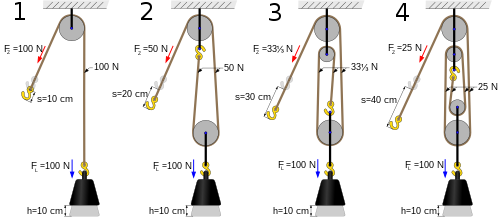
A simple machine that exhibits mechanical advantage is called a mechanical advantage device - e.g.:
Contents
- Lever: The beam shown is in static equilibrium around the fulcrum. This is due to the moment created by vector force "A" counterclockwise (moment A*a) being in equilibrium with the moment created by vector force "B" clockwise (moment B*b). The relatively low vector force "B" is translated in a relatively high vector force "A". The force is thus increased in the ratio of the forces A : B, which is equal to the ratio of the distances to the fulcrum b : a. This ratio is called the mechanical advantage. This idealised situation does not take into account friction.
- Wheel and axle motion (e.g. screwdrivers, doorknobs): A wheel is essentially a lever with one arm the distance between the axle and the outer point of the wheel, and the other the radius of the axle. Typically this is a fairly large difference, leading to a proportionately large mechanical advantage. This allows even simple wheels with wooden axles running in wooden blocks to still turn freely, because their friction is overwhelmed by the rotational force of the wheel multiplied by the mechanical advantage.
- A block and tackle of multiple pulleys creates mechanical advantage, by having the flexible material looped over several pulleys in turn. Adding more loops and pulleys increases the mechanical advantage.
- Screw: A screw is essentially an inclined plane wrapped around a cylinder. The run over the rise of this inclined plane is the mechanical advantage of a screw. [1]

